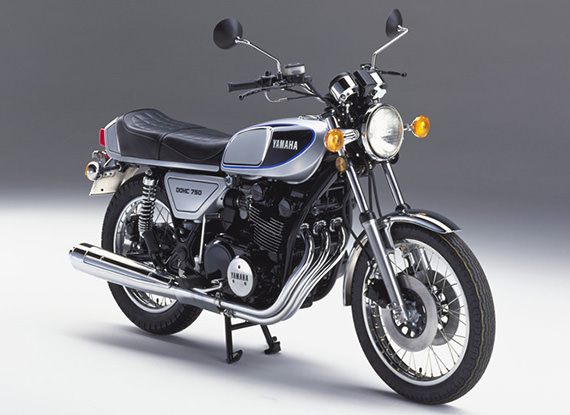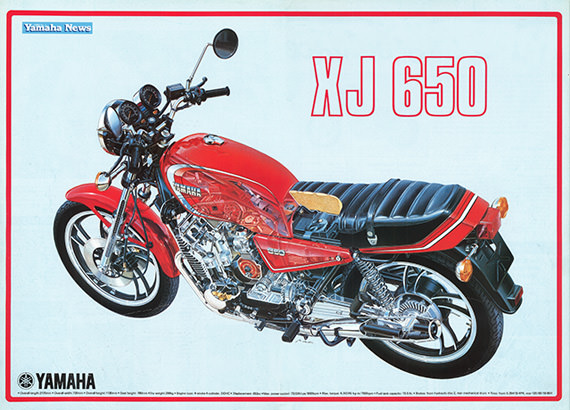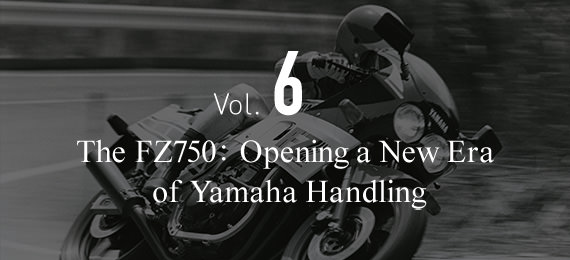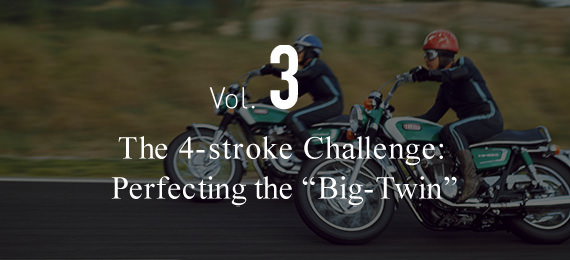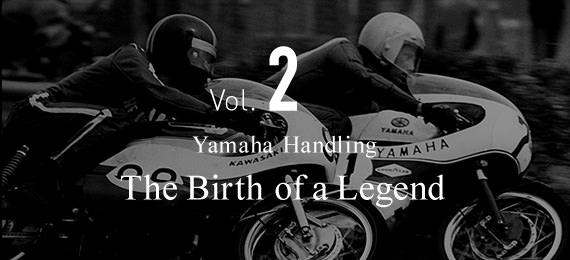The 3-cylinder GX750 debuts, but falls short
(Return to Part 1)
Perhaps it was due to the relationship of trust that we had built up, but Yamaha allowed me to serve as a road-test rider—from the tire manufacturer side—right from the early stages of its development for its next motorcycle model, the GX750. The model was to debut in 1976, but when I learned that it was a 3-cylinder,
I was a bit shocked. I thought that since Yamaha hadn’t been able to win customers with the big-twin route, this time, they would surely switch to a 4-cylinder format to compete with their rivals. Yamaha had gained so much expertise in the field of handling that a 4-cylinder machine from them would without a doubt leave the competition behind. Focusing on originality isn’t bad, but why choose such an eccentric engine format like a 3-cylinder...?
To top it off, it was shaft-driven. In Europe and other developed markets, big sport bikes were often used for long touring trips and practicality was important, so you could say that using a shaft instead of the more maintenance-heavy chain meant it was a more user-friendly design. It becomes more expensive, but going this route anyway is really what makes Yamaha the company that it is. It’s quite a serious approach for a company to adopt, but I did worry that this would take away from the active, lively image of both the model and Yamaha as a company.

GX750
The combination of a compact, DOHC, in-line 3-cylinder engine, maintenance-free shaft drive and 3-into-1 muffler resulted in a high-level balance of comfortable high-speed cruising performance, ride stability and light, agile handling.
(Released in 1976)
“This of course was true for the engine, but we put everything we’d learned from the TX Series about chassis and tires to work in developing the GX750,” says [the late] Takafumi Fujimori (Chief Engineer from Yamaha’s Road Testing Unit, 2nd Project Engineering Division). According to him, the GX750 was the first big bike Yamaha developed with a focus on handling.
“For example, until then, we would have a prototype bike for testing durability and a prototype for testing and checking the various functional parts, but we didn’t create prototypes specifically for testing handling and stability. For the first time, stability and handling were ranked at the same level in development as these other areas. In pursuit of better handling, we were diligent in trying all manner of things from the initial stages of development, like adjusting the front-rear weight distribution by increasing the load on the front wheel to increase stability and changing the offset of the front fork bracket.”
It was a bike that had an easy-to-ride character with a feeling of stability and a torquey engine, but its power and chassis characteristics didn’t come across as sporty.
Whether that was the reason or not isn’t clear, but it wasn’t warmly received by consumers, and the 3-cylinder GX750 evolved into the 4-cylinder XS1100. Around this time, the 400cc class of motorcycles was colloquially known as “1,000 Dollar Bikes” in the U.S. and became popular for their affordable prices and user-friendly ride, much like the way 50cc class sport bikes were perceived in the Japanese market. Yamaha released the GX400 and GX250 in-line twin models in response, but they were average performance-wise and had no defining features. The 2-stroke supersport bikes that created the “Yamaha Handling” reputation were not spared either, and the muting of the RD400’s exciting character in order to clear California’s emissions and noise standards brought forth talk that 2-stokes had no future. Yamaha would also go without any clear market winners in its lineup for some time. While worrying about such developments, I departed my job as a tire test rider, retired from GP racing and took a position as the editor in chief of RIDERS CLUB magazine in 1978.
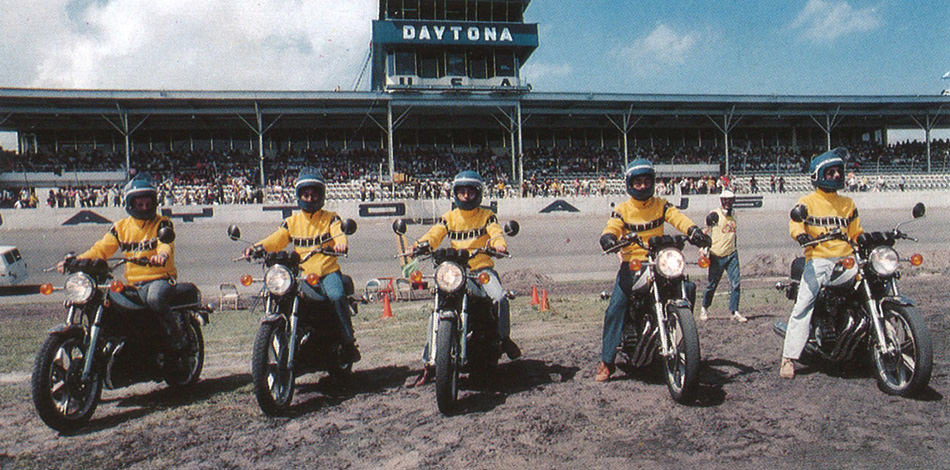
Crossing the U.S. for the GX750’s 10,000 km test-ride
A bold decision was made to test the GX750 right before its release with a 10,000 km test-ride across the U.S. in 1976. Excluding a single oil change, all five machines completed the journey without any maintenance or engine trouble.
The XJ650: A Culmination of Everything Yamaha Had Learned
Yamaha’s initial period of 4-stroke big-bike development, from its first generation of big-bikes (TX Series) in the early 1970s to its second generation (GX Series) in the late ‘70s, was akin to groping around for something in the dark. But in the 1980s, the advent of Yamaha’s third-generation of big-bikes and the fourth-generation mounting the engine completely revived the Yamaha Handling reputation. In addition, the legendary 2-stroke RZ250 came out, and Yamaha showed the industry its position as a top manufacturer behind the motorcycling boom of the era.
The trigger for this turnaround was the export model XJ650.
The XJ650 is an unforgettable model because of its fantastic handling, and I remember clearly how amazing it was to ride.
It was released in 1980, and we ran a special feature on it in July for the 25th issue of RIDERS CLUB.
“...the entire bike exudes a feeling that hasn’t been around since the YDS Series. Rather than debating whether it belongs to the supersport category or not, people who are looking for a more subtle type of appeal will surely find it has plenty to offer.” I see that I wrote this because it had been so long since I had been so taken by a bike with such a refined and uniquely Yamaha appeal. Its torquey engine felt sporty, powerful and usable, and it brought tears of joy to my eyes. And the article made me recall how its well-balanced handling with a solid base of natural front wheel steering characteristics with no oversteer even at low speeds and feeling of stability at mid- and high-speeds—while still having a light and agile feel—brought me a happiness that I couldn’t put into words.
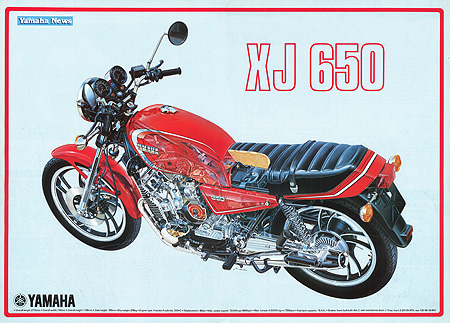
XJ650 cross-sectional illustration
The XJ650 was the embodiment of Yamaha’s pursuit of a lightweight, slim and compact chassis paired with a high-performance 4-cylinder engine. (Picture from the overseas-version of Yamaha News)
It was shaft-driven, but that wasn’t seen as a negative factor,
and the more you concentrated on your riding, the more you could enjoy the character and flavor of the bike’s handling. It was easy to ride, with no surprises, and you could feel how sporty it was when leaned over with it in a corner—rider and machine as one—and it ran the line you wanted. I remember I had nothing to complain about with the XJ650; it was pure, unadulterated fun, from the test course to the twisties.
Talking about its development, Fujimori says, “The concept or goal for the model was ‘200 kg, 200 km/h.’ This was groundbreaking at the time, and it was a target that would be impossible to reach without coming up with new methods for everything, including the way we’d think about its development. We aimed to bring in a new age of compactness and light weight. The decision for a displacement of 650cc also came from this idea. We put everything we had into creating a bike that handled well. It was about compiling everything we’d learned and achieved until then into one vehicle. This meant that right from the design stage, we included elements like weight distribution and chassis rigidity into the mechanical drawings, and it was also the first time we ever brought in the test riders to help while the model existed solely on paper.” He’d had such a difficult time since the development of the XS-1, so the XJ650 clearly was a special model for him.
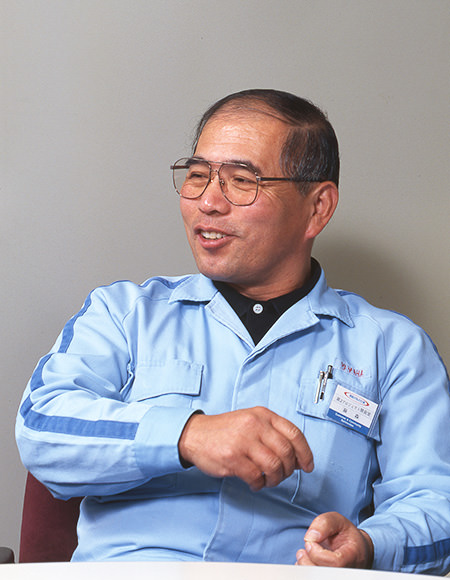
Takafumi Fujimori remembering the development of the XJ650 (1996)
“Discussing how we did things for the TX and the GX, we worked together with the engineers to figure out what to do for things like the machine’s center of gravity. By putting the alternator behind the engine, we were able to make the bike slimmer, more compact and further centralize the chassis’ mass. The results were clear from the first shakedown rides, and I could feel how this bike was really something different. The engineers that had struggled with us through the process shared in the achievement, and we all agreed that we had to make sure this kind of handling would be passed down to future Yamaha models.
I still think that the XJ650 was the first truly Yamaha 4-stroke bike we ever made. It also was probably the first time the engineers felt so much joy in developing a 4-stroke model. Even when we re-analyzed the bike with the latest technologies, its chassis balance was good, and it proved that we had put together a really solid motorcycle.”
Slightly Lower Handlebar Ends: The “Yamaha Position”
The XJ650’s excellence wasn’t solely due to its handling background. The development team was fastidious about every area the rider was in contact with. The shape of the fuel tank was the result of test riders getting on clay models numerous times to finely adjust it and make the tank easier to grip with the knees. The part that best shows these extensive efforts by the team is the shape of the handlebars.
“We were really particular about designing the position of the handlebars in a way that the rider didn’t have to ‘fight’ the bike. While riding on both the track and public roads, we had numerous discussions about the type of riding that would take full advantage of the model’s excellent and natural character. We finally realized that the point where you feel most unified with the machine is when banked over during a turn. It was then that we wanted the handlebar ends slightly lower and decided to alter them as such. We also changed the shape of the clutch and brake levers to enable riders to easily operate them with their fingers while firmly gripping the handlebars.”
There are many Yamaha sport bikes that have their handlebar ends positioned lower than those of the other manufacturers’ models in what is a unique design. It also seems that the better a model’s handling was, the more prominent this handlebar positioning was. The idea of making it so that riders don’t have to “fight” the bike when they ride is certainly one representative example of the attention to detail Yamaha has when it comes to its machines. Back then, after I’d finished test-riding it, I wondered about the shape of the handlebars, and when I asked, I learned how much effort the team had put into the shape. After hearing the stories from Fujimori and the other test riders and understanding how much love they had for riding motorcycles,
it made me appreciate even more what a great bike the XJ650 was.
Later, the bigger displacement model XJ750 would be released for sale on the Japanese domestic market and would go on to become a very popular model that older motorcycle fans surely remember. The XJ750 was known for its sporty character and smooth, rider-friendly handling, but it was the XJ650 that was built with a focus on total balance that left a stronger impression on me, and the members of the development team shared this opinion.
The XJ Series’ engines would eventually be souped-up to 900cc, and even after the 5th-generation engine replaced the 4th-generation Genesis engine as Yamaha’s primary power unit, the XJ900 continued to be produced and became one of Yamaha’s long-selling models.
The Golden Age of Supersport Bikes Arrives Led By the XJ400
Yamaha had finally created 4-cylinder bikes that put it on a level playing field with its rivals. As if unleashing pent up steam all at once, Yamaha regained its position as the manufacturer of supersport bikes with amazing performance—originating from their excellent handling—and won many fans in the process.
One of the main driving forces in this turnaround was the XJ400 model that was developed alongside the XJ650. It was given the same new engine and layout as the XJ650—with the alternator located behind the cylinder block and other features—and the chassis was also created with the knowhow fed back from the XJ650, thus its development proceeded smoothly with no significant issues to overcome.
With Japan’s 400cc user preferences in mind, it had a relatively large chassis with good stability. Despite this, the XJ400 had light, agile handling thanks to its unsprung components. The ride quality it produced was very much Yamaha’s “in tune with the rider” style and demonstrated how superior it was to its rivals. Naturally, this easy-to-ride character won it much praise and it quickly became a big seller.
But, what’s also curious is that the development of this well-known and successful machine wasn’t full of challenges. I believe this is due to the way Yamaha had taken on developing big bikes at the time, overcome the handling problems they faced, such as the wobbling at high speeds resulting from the heavy weight, bigger engines and the bigger power they produced, and gained more and more expertise as they marched forward. All of this knowhow was fed back into the 400cc model, giving it plenty of chassis performance to achieve excellent handling without much difficulty in development.
For 2-strokes on the other hand, the YZR500 was competing in the World GP and knowhow gained from the race machine would be fed back into new development challenges by Yamaha, leading to models from the RZ250 to the TZR250.
(Continues in Vol. 5)
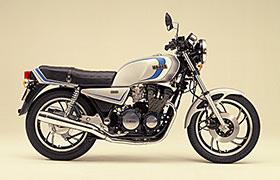
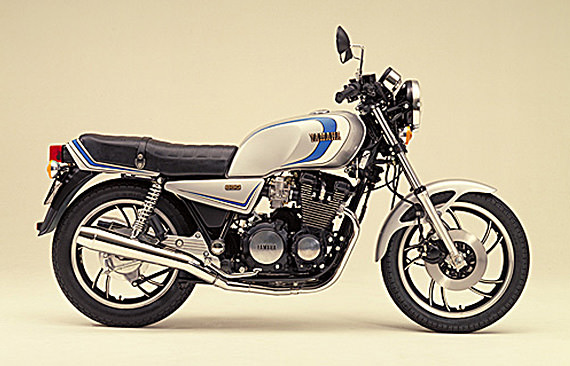
XJ650
The XJ650 was Yamaha’s first big 4-stroke bike to win a reputation as having the
“best handling.” For the Japanese market, it was given a displacement boost to 750cc and was sold as the XJ750. As you can see, the styling gave top priority to riding functions while still coming together in a beautiful package, and you can see its connections to the XJR Series of today. For its main specs, the XJ650’s engine put out 73 PS at 9,000 rpm, while the bike itself weighed 206 kg and had a wheelbase of 1,435 mm. The engine on the XJ750 model put out 70 PS at 9,000 rpm and the bike weighed 214 kg.
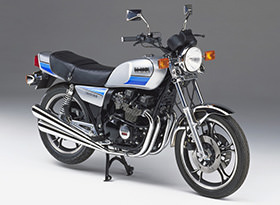
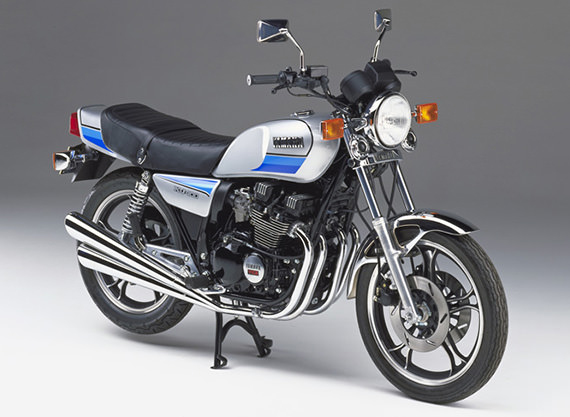
XJ400D (4-pipe muffler spec released in 1981)
The XJ400 deserves special mention as Yamaha’s first 4-stroke supersport bike that went on to become a huge hit. There are many users that got their motorcycle licenses with this model and went on to love and ride it for a long time. After it was released, a version with a 4-pipe muffler came out and brought the model even greater popularity.
It can be considered a sibling of the XJ650 and XJ750 models since it was developed with feedback from both of them, from its design to its hardware. Its handling was also similar, with good stability and a feeling of assurance. The soft, supple suspension produced a light and pleasant feeling to the ride that was well-regarded. It’s this handling that feels so in tune with rider perceptions that represents the post-YDS tradition of Yamaha Handling, and symbolizes the base that Yamaha has faithfully maintained with its sport bikes to this day.
In other words, it’s when riders can feel at ease on the bike, and that assurance encourages them to try riding more aggressively through corners and the like. It's here that we see Yamaha’s philosophy of not overly pursuing the performance of the chassis alone stand out. This is something that would become the topic of much discussion and debate within the company when the era of racer-replicas began. As for its specs, the XJ400’s engine had a power output of 45 PS at 10,000 rpm while the bike had a weight of 176 kg and a wheelbase of 1,405 mm.



